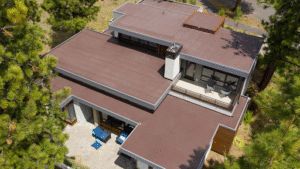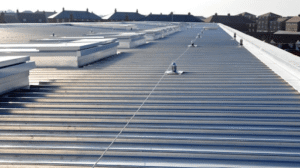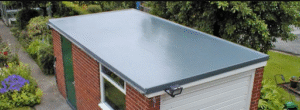For homeowners wanting to make the most of their space, opting for flat roofing could be a smart idea. From modified bitumen roofing to EPDM and more, several types of flat roofing systems give your home a modern look and should be at the top of your list whenever you’re planning to replace an existing roof or build a new house. Gable Roofing has created this short article based on its vast experience, and recommends three flat roofing options that you should keep in mind.
Flat Roofing—What Is It?
Let’s cover the basics first. What exactly defines flat roofing? A flat roof is not completely flat, as the name might suggest. It is a type of roof with a very low slope, 10 degrees or less. According to IKO Global, they are usually constructed using a deck, a vapor barrier, and a roof board.
The roofing system you opt for influences the flat roof materials used. So Choose Wisely!
| Fun Fact:
The US market for flat roofs is 6.99 billion in 2025 and is estimated to rise to 16.7 billion by 2032, showing its rise among the ranks of roofing systems |
Types of Flat Roofing Systems
Alright, so what kinds of flat roofing are out there? Though there are several types, there are three main ones that every homeowner should keep in mind when going for a roofing project
-
First, Modified Bitumen Roofing – MBR
A modified bitumen roofing system is a single-ply roofing system that modifies asphalt with polymers, with fiberglass or polyester reinforcement to make it more durable. According to Lifetime Flat Roofs, it is more durable than BUR, but not as much as EPDM. Due to its resistance to UV damage, it is ideal for areas that receive a lot of sunlight.
-
Up next, EPDM
Ethylene Propylene Diene Monomer is widely used in commercial flat roofing, along with residential. It is highly durable, resistant to temperature change, and UV radiation. The flat roof lifespan is around half a century, making it a solid choice for homeowners.
-
Last but not least, metal roofs
By far the most durable out of all three roofs, metal roofs are made of copper, tin or steel. They can last for over 50 years and require little maintenance. What’s more is that they are the most energy-efficient roofing among all three, making them a smart investment choice.
Why opt for flat roofing systems? – Perks to consider
Alright, you get it. Flat roofing isn’t as one-dimensional as it sounds. It has multiple layers and facets, contributing to its charm. The wind resistance, easy installation, and whatnot, it has its perks that we are sure you will enjoy.
But what are some advantages of having flat roofs instead of pitched ones? We’re glad you asked! Let’s take a look at a few:
-
Ease of Installation
Flat roof installation is typically easier than any other kind. Involving lower labor costs and making it a budget-friendly option for homeowners.
-
Resistance to wind damage
Due to their low profile, they stand a better chance against harsh winds, making them a good choice for windy areas.
-
Additional space
If you live in a suburban area, opting for flat roofing systems would give you additional space to use. You can convert them into patios or storage units, resulting in a spacious main house.
-
Rooftop equipment
Solar panels and HVAC systems can easily be set up on flat roofs, keeping your home comfortable throughout the year.
-
Flat roof repair and maintenance
Another advantage, due to their architecture, they’re easy to inspect and repair in case of damage, and flat roof maintenance is also less complicated than pitched roofing.
-
Brighter interiors
Flat roofs also have the unique advantage of skylights. Not only does this mean more natural light, but it also improves ventilation, provides vitamin D, and lowers energy costs.
| Here’s an idea!
Install a rooftop garden to improve insulation, promote biodiversity, eat healthier, and manage stormwater. |
Conclusion
In short, flat roofing is slowly gaining traction among homeowners due to perks like low maintenance, cost-effectiveness, and versatility. With the right flat roof drainage system, options such as EPDM, MBR, and metal can be very smart choices for homeowners planning on a roofing project sometime soon. This article has given you three types of flat roofing options to consider for your next roofing project, but in case of more questions, feel free to drop us a line!
FAQs
How do flat roofs drain water?
Flat roofing is sloped to the middle or corner, where a drain takes all the water to the main sewer system. Think of it like the sink in your bathroom.
What types of materials are used for flat roofs?
Common materials include TPO, EPDM, BUR, and PVC.
How to care for flat roofs?
Regular cleaning of dirt, loose leaves, etc., plus trimming back any nearby trees.
What influences the lifespan of a flat roof?
Things like the climate, installation, flat roof waterproofing, and material used play significant roles in the lifespan of flat roofing
What are some signs that I need a flat roof replacement?
Persistent leaks, sagging, blistering, and cracks are some signs you need to change your flat roof.
What should I consider when opting for flat roofing for my home?
Keep in mind things like design preferences, future goals, cost, and local climate when deciding on a flat roofing system.




